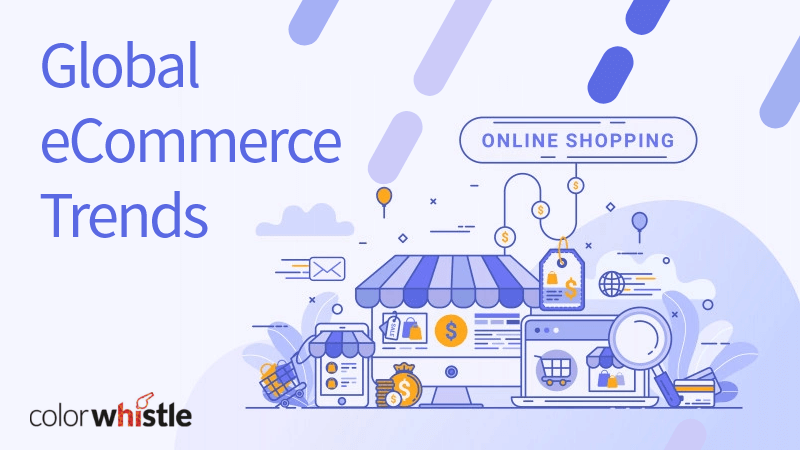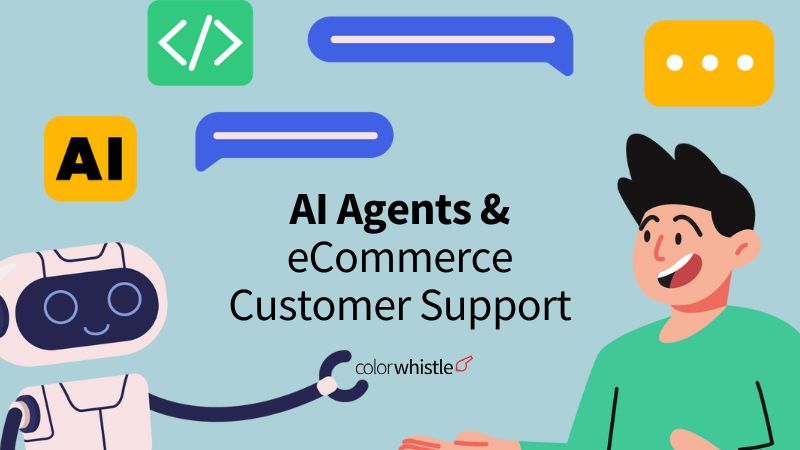Though the global eCommerce industry is growing slowly, it’s at an all-time high due to the COVID-19 pandemic. The eCommerce share of the retail industry has increased from 10.4 % in 2017 to 18.1% in 2021, and it expects a growth of 22% in 2023. Whatever may be the reason, eCommerce becomes more competitive in the next five years than ever.
To understand global eCommerce trends, it’s significant to go through the eCommerce industries of major countries like the USA, and the UK, and India.
A look at US eCommerce Industry
The year 1995 witnessed the birth of the eCommerce giant Amazon, which was first launched for books and with time it shifted to every single product. With the launch of PayPal, the payment gateway in 1999, the eCommerce industry has widened its scope. In 2000 Google introduced Google Adwords, where one can run an ad in the google search engine. It increases clicks and customers, this is now proved as a blessing for all eCommerce or online service providers. With this, an era of digital inventions has started, and it is never back from that.
2005, came up with cyber Monday, through which eCommerce gained great growth and popularity. On the other hand, Amazon introduced prime membership which allowed the prime member some perks.
By 2017, eCommerce has set up the sales bar by generating $29.267 trillion. With the coming up of COVID-19, around 80-90% of people shifted their shopping from offline to online, which generated and expanded the growth of the eCommerce sector. According to Statista, the online sale in the US during the year 2016 was around $ 390 billion and it’s expected to surpass $700 billion by the year 2022.
In fact, the US eCommerce is now on track for its first $1 trillion year by 2022, due to lasting pandemic impacts. Online grocery has benefited from the change in consumer behavior and doesn’t show any signs of slowing.
Here are the leading online companies in the USA
Fashion – Gap.com, Nordstorm.com, Kohls.com, Walmart.com, Qvc.com
Travel – 4Booking.com, Airbnb.com, Orbitz.com, Agoda.com, Expedia.com
Education – Masterclass.com, Newsela.com, Civitaslearning.com
Food and grocery – Amazon.com, Blueapron.com, Homechef.com, Crowdcow.com
Health – Teladoc.com, memd.net, Icliniq.com, Amwell.com
Entertainment – Thewaltdisneycompany.com, Viacomcbs.com, Warnerbros.com, Netflix.com
Furniture – Anthropologie.com, Etsy.com, Westelm.com, Amazon.com, Worldmarket.com
Also Read
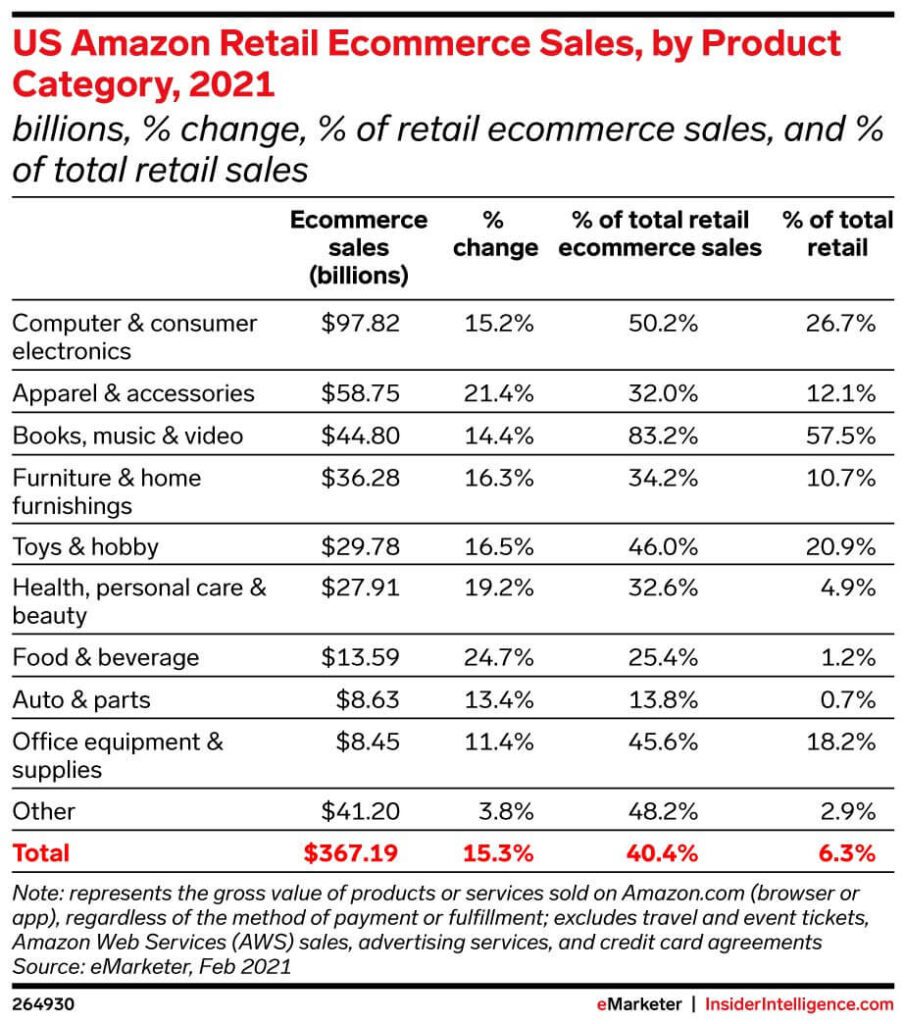
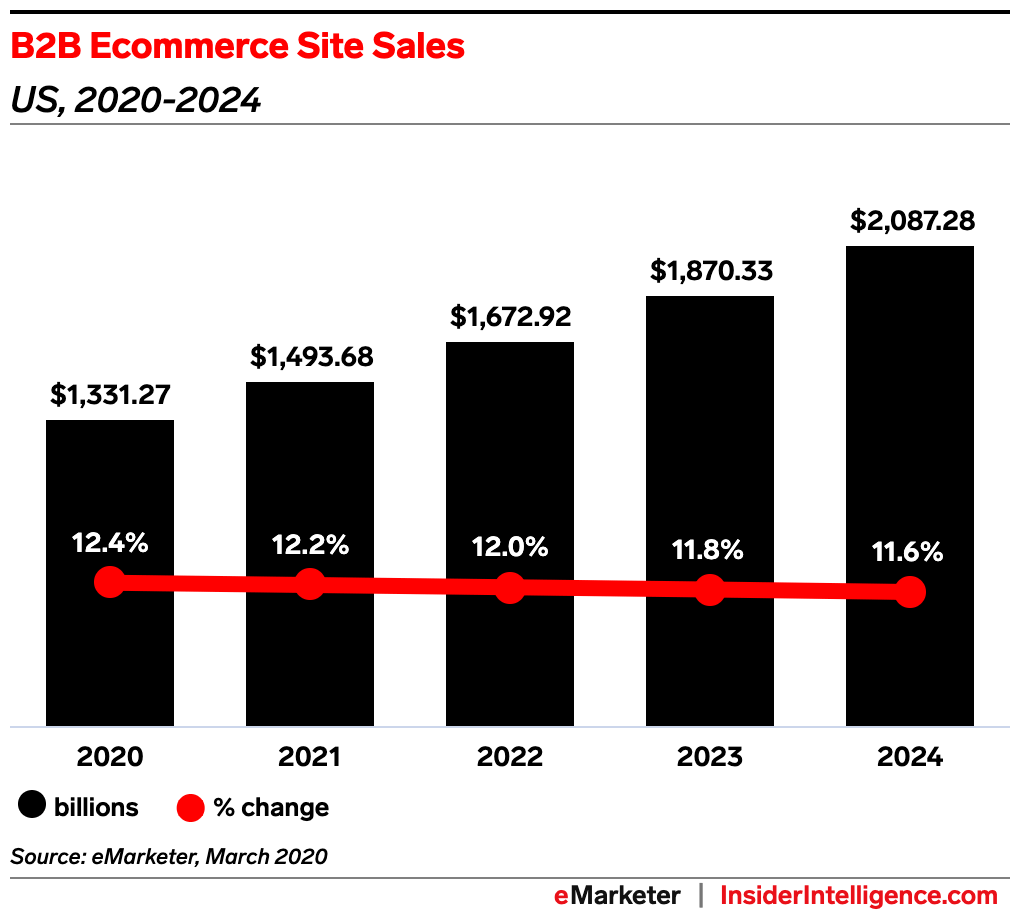
UK eCommerce Industry
Being one of the significant eCommerce markets in the world, the UK eCommerce market is the biggest player with Amazon, Tesco, and eBay.
A report from Ecommerce Foundation, eCommerce sales reached 200 billion euros in 2019. As per the same, the UK’s 7.94% of GDP is generated by eCommerce sales alone.
According to Statista, the revenue from the eCommerce market is expected to reach 80678 euro million in 2021. The last year witnessed a 34.7% increase in eCommerce sales due to the pandemic. In the UK, Amazon is the giant that benefited from the pandemic, and it has added an extra 2 billion euros of sales to the UK eCommerce market.
The Statista report says the UK customers are mainly shopping for clothes and sports goods followed by fast food. With the advent of Augmented Reality and personalization, the UK eCommerce market continues to grow faster than ever.
Here are the leading online stores in the UK
Fashion – Next.co.uk, Asos.com, Jdsports.co.uk, Argos.co.uk, Newlook.com, Adidas.co.uk
Travel – Skoosh.com, Netflights.com, Alpharooms.com, Lastminute.com
Education – Looop.co, Hubkengroup.com, E-learningwmb.com, Virtual-college.co.uk
Food and grocery – Tesco.com, Amazon.co.uk, Ocado.com, Waitrose.com, Morrisons.com, Iceland.co.uk
Health – Pushdoctor.co.uk, Huma.com, Babylonhealth.com, Ceracare.co.uk, Lumeon.com, LumiraDx.com
Entertainment – Bbc.co.uk, Dazn.com, Whathifi.com, Musicmagpie.co.uk, Ents24.com
Furniture – Wayfair.co.uk, Argos.co.uk, Ikea.com, Dunelm.com
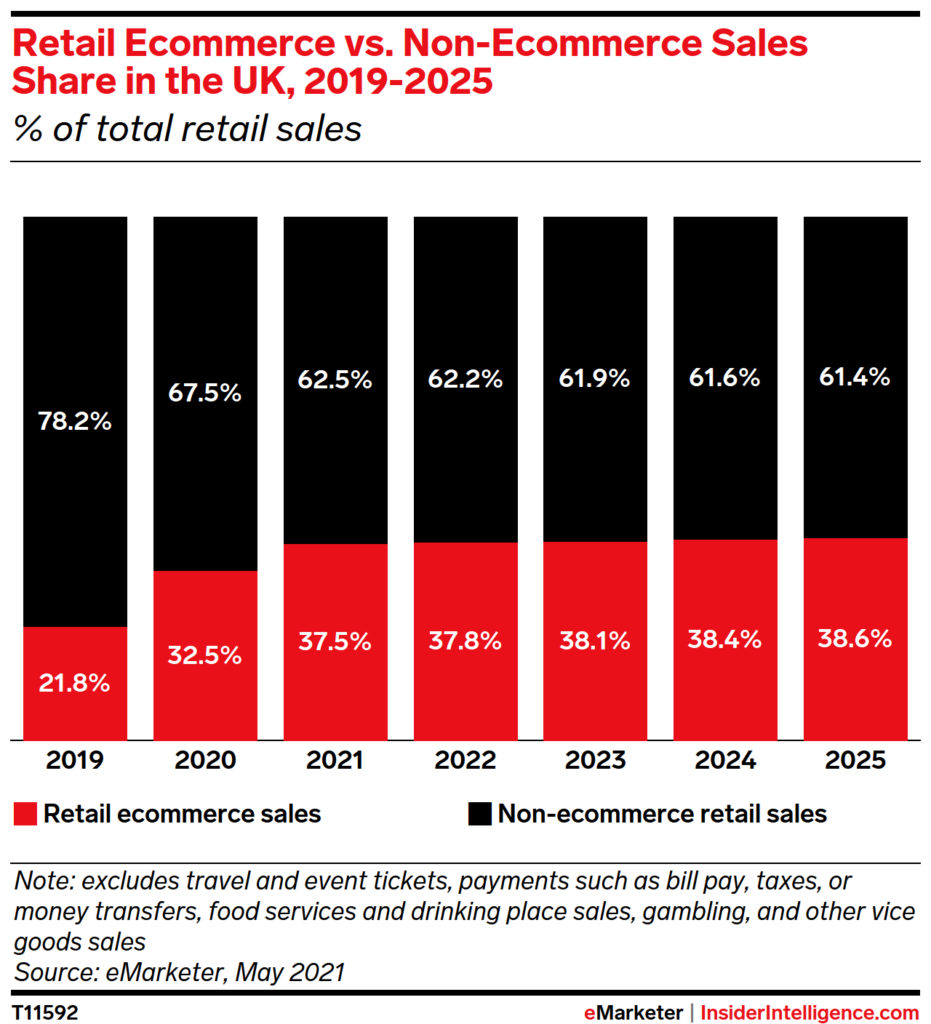
Also Read
What’s the Indian eCommerce Industry like?
Despite the early in-roads of eCommerce platforms in India and a healthy retail industry in India that is growing (US$ 600 billion in 2016 and US$ 1 trillion in 2020), the eCommerce sector in India accounts for only 2% of India’s total retail industry.
Not everything seems bad. The penetration of smartphones and high-speed 3G/4G data has brought a significant change in the eCommerce sector, post-2014. In 2015, the online internet shoppers were 11% of the Indian population, and in 2020, it reached 36% due to infrastructural developments such as digital advertising, digital payment, etc.
The pandemic has played a significant role in increasing the eCommerce retails when comparing 12.2% growth in 2018 to expected 16.8% growth in 2021 as per the GlobalData.
Here are the leading eCommerce companies in India:
Travel – Makemytrip.com, Yatra.com, Cleartrip.com, Goibibo.com, Booking.com
Fashion – Jabong.com, Myntra.com, Zovi.com, Yepme.com, Limeroad.com, Amazon.in, Snapdeal.com, Flipkart.com, Limeroad.com
Food and grocery – Amazon.in, Snapdeal.com, Flipkart.com, Zomato.com, Foodpanda.in, BigBasket.com, Grofers.com
Furniture – Fabfurnish.com, Pepperfry.com, Urbanladder.com
Education – Purple.com, Squirrel.com, Eduventures.com, Plancess.com
Health – Portea.com, Healthkart.com
Entertainment – Netflix.com, Hotstar.com, Hooq.com, ErosNow.com
The key challenges faced by the Indian eCommerce industry today:
Digital Illiteracy: Hardly, 38% of households in India are digitally literate, with urban households outweighing rural households.
Cash-on-delivery: Most customers prefer cash-on-delivery, and it increases the chances of return that affect both the online shopping platform and the sellers.
Network speed: It’s essential to have a proper network to access eCommerce platforms by using smartphones, desktops, laptops, etc. The transaction failures are due to the absence of high-speed bandwidth everywhere and the intricacies of payment gateways.
Poor delivery and reverse logistics: The lack of proper customer delivery methods and inefficient reverse logistics may hinder the proper functioning of the eCommerce industry.
Over a dozen brands that started off as pure-play eCommerce businesses have an offline presence now, opening brick-and-mortar outlets in a bid to chase profitability. According to the NASSCOM predictions, the approximate value of the eCommerce industry was 50 billion USD in 2018 and is expected to reach 200 billion USD by 2027.
The improved social commerce, the rise of m-commerce, online dispute resolution for digital payments, and more provide considerable contributions to the development of the Indian eCommerce industry.
What Has Changed in the eCommerce Industry Over The Years?
Understanding the future of the eCommerce industry is incomplete without discussing the ongoing trends:
AI and ML Integrations
Online retailers use Artificial Intelligence (AI) and Machine Learning (ML) to provide chatbot services, analyze customer reviews, etc. It has brought considerable changes to the live chat customer support. The chatbots are designed to provide a quick response to customer queries. According to a study conducted by Ubisend, 20% of customers purchase goods and services after having a chatbot query and online retailers also offer great deals on chatbots.
E.g., Alibaba uses AI and ML for smart logistics that help them to reduce 10% of their vehicle use and 30% of their total travel distance.
Some major AI and ML applications in the eCommerce sector:
- Chatbots and other virtual assistants
- Personalized product recommendations
- Inventory management
- AI-based email marketing campaigns
- AI-enabled data analytics
- ML for product pricing
- ML for language translation
- ML for route planning
AR and VR in eCommerce
In the year 2020, the global eCommerce sale was $4.6 trillion, however, 77.3% of people leave their cart without completing the purchase. Here the role of Augmented Reality (AR) and Virtual Reality (VR) would become more significant.
One of the popular applications of AR is VTOs- Virtual Try-On solutions. The technology facilitates customers to see themselves in a product on their screen. Interactive user manuals, another significant result of AR technology, facilitate users to learn about a particular product, its features, and how to set it up. VR is also a better tool to offer a feeling that the customers are in a traditional store rather than in an online shopping platform. VR stores allow customers to benefit from virtual staff, interaction with 3D products, and more.
You may be interested in reading AI/ML inspirations in the e-learning industry
eCommerce SEO
The comprehensive structure of eCommerce SEO has changed due to the pandemic. According to Nielsen reports, the volume of video search has increased, and it’s 100% for some products. YouTube is the second largest and most visited website; therefore, video content is more popular than before the pandemic. As per the study conducted by HubSpot, 64% of companies invest money in SEO.
eCommerce SEO quick tips:
Optimize eCommerce site for voice search: Make sure that you are using the proper schema to respond quickly to the customer voice search for a product like yours.
Renew SEO best practices: Update keyword research and on-page optimization that reflects customer behavior. The real-time monitoring of future trends and demands helps to plan better SEO campaigns.
SEO Automation: intelligent automation can free up valuable time for developing a more efficient and performance-based SEO strategy.
eCommerce SaaS
While compared with traditional eCommerce platforms, SaaS eCommerce, a cloud platform, is more convenient to manage an online store. When we choose SaaS eCommerce, the hosting provider is responsible for the performance, speed, updates, etc. By the end of 2020, the SaaS market capitalization was USD 126 billion, and it’s expecting to reach USD 143 billion by the year 2022. The eCommerce industry has also benefited from SaaS as it allows even small retailers to launch a fully functional and easy-to-manage web store at a minimum cost.
Consider switching to one of these highly-rated CMS for online businesses.
Also Read
Personalized Customer Experience
Personalizing the eCommerce experience is essential in the digital realm of retail marketing. While brands using the personalized experience, 80% of online shoppers choose that particular brands’ products and services. AI/ML-powered technologies such as chatbots, smart sensors, IoT infrastructures, and more can deliver a personalized experience to the customers.
E.g., Amazon’s search recommendations or even Nike’s 3D sneaker customization campaign are two entirely different examples yet they both provide personalized shopping experiences.
A report by Adobe found that the BOPIS (buy-online-pickup-in-store) model is here to stay. In an Adobe survey of over 1,000 U.S. consumers, 30 percent of online consumers prefer curbside/in-store pickup over standard delivery options.
Here’s how you can price and arrange items on your eCommerce site for maximum sales.
eCommerce Marketing
eCommerce marketing is all about driving awareness of your product or service and leading visitors through the sales funnel. Key statistics of WooCommerce vs Shopify can provide valuable insights into the performance and popularity of these two popular eCommerce platforms. eCommerce marketing continues to rely on tested strategies like social media marketing, content marketing, search engine marketing, email marketing, influencer marketing, affiliate marketing, and so on.
Here’s a chart that shows how eCommerce marketing and social media are glove-in-hand and users from which country make a purchase via any of the social media channels the most.
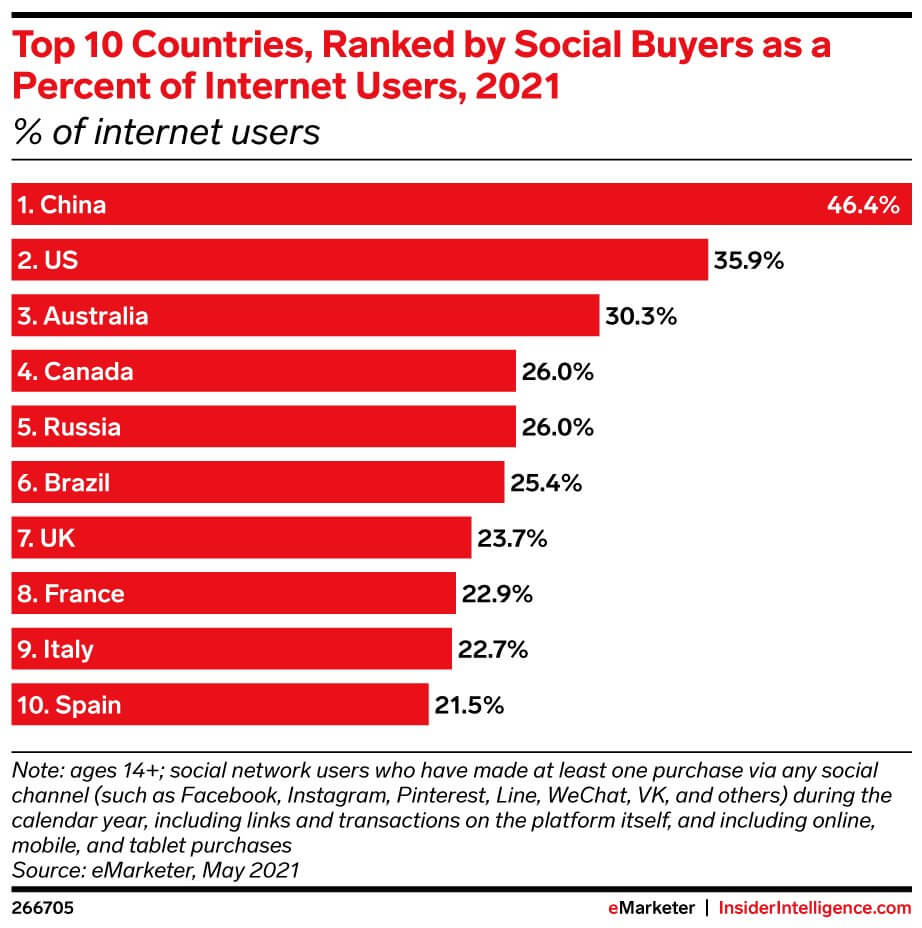
Adobe Analytics also found an interesting trend where Buy Now, Pay Later option is much preferred. This payment method is seeing a boom, with 215 percent YoY growth in the first two months (Jan-Feb) of 2021. Consumers using this service are also placing orders that are 18 percent larger. Retailers are offering the buy now/pay later option more often, while consumers deal with financial uncertainty.
You may be interested in reading how these online businesses marketed themselves well during the pandemic.
Looking for eCommerce Development Services?
Seize and experience the transformative impact of eCommerce Development Services & Solutions with ColorWhistle.
Wrapping Up …
All the data shared above points out things such as,
- on business-end: online shopping is the future, ensure to follow eCommerce store maintenance checklists to get better results in SEO. Also, SEO activities on eCommerce sites need to link more with social media or real-time monitoring is essential, SaaS platforms prove to be more convenient to manage an online store.
- on user-end: adapting technology innovations like AI/ML to make shopping a more personalized experience.
In fact, in countries like India, the rise of O2O (Online-to-Offline) commerce is seeing a steady rise and would be least affected by the pandemic scenario, at least for this decade.
If you are looking for an eCommerce partner to create an online store and an online marketplace, our ColorWhistle team is here to help. Share the details of your project by either sending a message through our contact form or giving us a call at +1 (210) 787-3600.
Feel free to share your thoughts on this blog post in the comments section below.
In quest of the Perfect eCommerce Development Services & Solutions Buddy?
Be unrestricted to click the other trendy writes under this title that suits your needs the best!
- Top Beauty & Lifestyle E-commerce Websites – A Tech Audit
- E-commerce Websites of Top Luxury Fashion Brands
- Top Grocery E-commerce Websites – A Tech Audit
- E-Commerce Website Design Trends to Look Out
- How to Build a Marketplace / Multi-Vendor Website
- 28+ Best Kitchenware and Furniture Website Design Inspiration
- 11 Successful Online Kitchenware Store Website’s Inspiration
What’s Next?
Now that you’ve had the chance to explore our blog, it’s time to take the next step and see what opportunities await!

